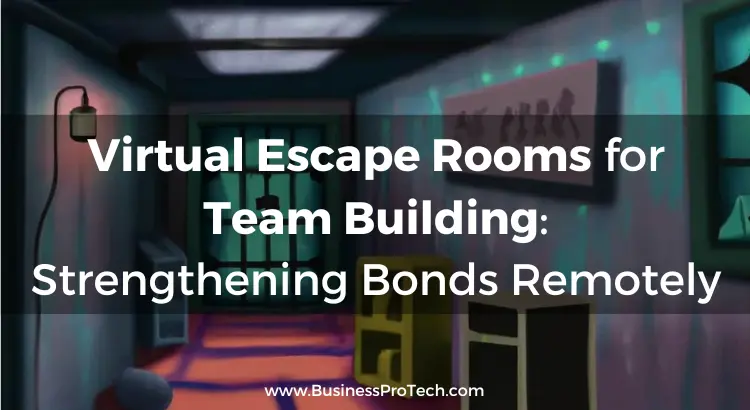In today’s digital age, remote work has become increasingly prevalent, transforming the way teams collaborate and interact. However, distance can often create a sense of disconnection among team members. That’s where virtual escape rooms come in. These immersive online experiences have gained popularity as a unique and effective way to strengthen bonds remotely.
In this article, we’ll explore how virtual escape rooms work and how they help bring teams closer together, enhance communication and problem-solving skills, and ultimately foster a stronger sense of unity.

The Importance of Team Building in Remote Work Environments
Remote work offers numerous benefits, such as flexibility and increased productivity. However, it also presents challenges, particularly when it comes to team dynamics. Without the physical presence and spontaneous interactions of shared office space, team members may struggle to build rapport and maintain strong connections. This is where team-building activities become crucial in bridging the gaps created by distance.
Team building exercises help foster a sense of unity, boost morale, and improve collaboration among team members. In remote work environments, where face-to-face interaction is limited, it’s even more important to invest in activities that bring teams together virtually. Virtual escape rooms provide an exciting and engaging platform for remote team building, as they offer a unique blend of problem-solving, communication, and collaboration.
Understanding Virtual Escape Rooms
Virtual escape rooms are online adaptations of the popular physical escape rooms, where participants work together to solve puzzles, uncover clues, and ultimately escape within a given time limit. Through innovative technology and engaging gameplay, virtual escape rooms recreate the thrill and excitement of their physical counterparts in a virtual setting.
These virtual experiences often take place through video conferencing platforms, allowing team members to communicate and collaborate effectively in real time. Players can interact with their environment, examine objects, and solve puzzles by working together, all from the comfort of their own homes or remote workspaces.
Virtual escape rooms come in various themes and difficulty levels, catering to different interests and skill sets. Some may focus on mystery-solving, while others may incorporate elements of fantasy or adventure. The diversity of options ensures that teams can find an experience that aligns with their preferences and goals.

Strengthening Bonds through Virtual Escape Rooms
One of the primary reasons virtual escape rooms have become a powerful tool for team building is their ability to foster collaboration and strengthen bonds among team members. Unlike traditional team-building activities that may feel contrived or forced, virtual escape rooms provide a structured yet engaging environment that encourages genuine cooperation.
In a virtual escape room, team members must communicate effectively, share information, and delegate tasks to successfully solve the puzzles and escape. This collaborative nature not only enhances teamwork skills but also allows participants to gain a deeper understanding of each other’s strengths, weaknesses, and problem-solving approaches.
Moreover, the sense of urgency and shared goal in a virtual escape room can create a heightened level of engagement and excitement. As team members work together to overcome challenges and unravel mysteries, they form lasting memories and shared experiences that contribute to a sense of camaraderie.
Team members who might not have interacted extensively in a remote work environment now have an opportunity to collaborate and bond in a fun and immersive setting. Virtual escape rooms break down barriers and help build connections among individuals who may have never met face-to-face, fostering a sense of unity and teamwork.

Designing Effective Virtual Escape Room Team Building Activities
To ensure the success of virtual escape room team-building activities, it’s essential to choose the right experience for your team. Consider factors such as team size, skill levels, and the desired level of difficulty. Some virtual escape rooms are specifically designed for team building and offer tailored challenges that promote collaboration and communication.
When selecting a virtual escape room, look for experiences that align with your team’s interests and goals. Whether your team enjoys solving mysteries, exploring historical settings, or embarking on adventurous quests, there is a virtual escape room out there that suits your needs.
Additionally, facilitators should plan and structure the activity carefully. Provide clear instructions and guidelines, establish a designated time limit, and allocate roles within the team to encourage active participation from all members. Encourage open communication and ensure that everyone has an opportunity to contribute their ideas and insights.
During the virtual escape room experience, it’s crucial to foster an inclusive environment where everyone’s ideas and contributions are valued. Rotate team roles throughout the activity to promote equal participation and showcase different skills. By involving everyone and creating a level playing field, virtual escape rooms can help break down hierarchical barriers and foster collaboration among team members.
After the virtual escape room experience, it’s essential to facilitate a debriefing session to reflect on the team’s performance, identify areas for improvement, and celebrate achievements. This debriefing provides an opportunity for open and honest communication, allowing team members to share their thoughts and experiences, and further strengthening the bonds formed during the virtual escape room activity.
Success Stories: Real-Life Examples of Virtual Escape Rooms for Team Building
Many companies and organizations have already experienced the positive impact of virtual escape rooms for team building. For instance, XYZ Corporation, a global technology firm, implemented a virtual escape room activity for their distributed teams. Through the immersive challenge, team members were able to collaborate effectively, boost morale, and strengthen interdepartmental relationships. This resulted in increased productivity and a more cohesive work environment.
Another success story comes from ABC Consulting, a remote consulting firm that struggled with team cohesion due to geographical barriers. By incorporating virtual escape rooms into their team-building initiatives, they noticed significant improvements in communication, problem-solving, and overall team dynamics. Virtual escape rooms provided a shared experience that brought their remote team closer together, transcending physical distance and fostering stronger connections.
These success stories demonstrate the versatility and effectiveness of virtual escape rooms as a team-building tool. By leveraging technology and fostering collaboration, organizations can bridge the gap created by remote work and create a sense of unity among team members.

Tips for Maximizing the Impact of Virtual Escape Rooms for Team Building
To ensure maximum impact from virtual escape rooms for team building, consider implementing the following tips:
- Encourage open communication and active participation throughout the experience. Make sure all team members feel comfortable contributing their ideas and insights.
- Foster an inclusive environment where everyone’s ideas and contributions are valued. Encourage collaboration and respect for diverse perspectives.
- Rotate team roles to promote equal participation and showcase different skills. This allows team members to develop a deeper understanding of each other’s strengths and enhances overall team dynamics.
- Follow up the activity with team discussions to reflect on the experience and identify lessons learned. Encourage open and honest feedback to foster continuous improvement and growth.
- Incorporate virtual escape rooms as part of regular team-building initiatives to maintain engagement and strengthen bonds over time. Virtual escape rooms should be seen as an ongoing process of team development rather than a one-time event.
By implementing these strategies, organizations can make the most of virtual escape rooms to enhance team dynamics, boost morale, and foster a collaborative work environment.
Final Words!
In an era of remote work, building strong bonds among team members is crucial for the success of any organization. Virtual escape rooms offer an innovative solution to bridge the distance and create a sense of camaraderie in remote teams. By leveraging the collaborative nature of these experiences, teams can enhance communication, problem-solving skills, and teamwork, ultimately strengthening the bonds that unite them.
Virtual escape rooms provide a platform for remote team members to engage in shared experiences, overcome challenges together, and celebrate achievements. These activities break down barriers, foster collaboration, and create a sense of unity that transcends physical distance.
So, consider incorporating virtual escape rooms into your team-building initiatives and witness the transformation of your remote workforce into a connected and cohesive team.